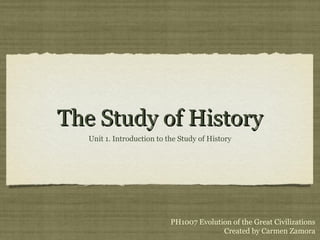The Study of History
•Download as PPT, PDF•
1 like•934 views
This document discusses the study of history, including what history is, how historians analyze evidence from multiple disciplines and perspectives, and different ways of measuring time across cultures. It also outlines how history is typically periodized, with examples given of periodizations from a European and global perspective. Historians rely on primary and secondary sources as tools to analyze the human past.
Report
Share
Report
Share

Recommended
More Related Content
Viewers also liked
Viewers also liked (7)
Similar to The Study of History
Similar to The Study of History (20)
Elements of Historiography : Trends and Approaches

Elements of Historiography : Trends and Approaches
More from mczamora
More from mczamora (18)
Recently uploaded
https://app.box.com/s/tkvuef7ygq0mecwlj72eucr4g9d3ljcs50 ĐỀ LUYỆN THI IOE LỚP 9 - NĂM HỌC 2022-2023 (CÓ LINK HÌNH, FILE AUDIO VÀ ĐÁ...

50 ĐỀ LUYỆN THI IOE LỚP 9 - NĂM HỌC 2022-2023 (CÓ LINK HÌNH, FILE AUDIO VÀ ĐÁ...Nguyen Thanh Tu Collection
Recently uploaded (20)
50 ĐỀ LUYỆN THI IOE LỚP 9 - NĂM HỌC 2022-2023 (CÓ LINK HÌNH, FILE AUDIO VÀ ĐÁ...

50 ĐỀ LUYỆN THI IOE LỚP 9 - NĂM HỌC 2022-2023 (CÓ LINK HÌNH, FILE AUDIO VÀ ĐÁ...
Basic Civil Engineering Notes of Chapter-6, Topic- Ecosystem, Biodiversity G...

Basic Civil Engineering Notes of Chapter-6, Topic- Ecosystem, Biodiversity G...
Benefits and Challenges of Using Open Educational Resources

Benefits and Challenges of Using Open Educational Resources
plant breeding methods in asexually or clonally propagated crops

plant breeding methods in asexually or clonally propagated crops
Matatag-Curriculum and the 21st Century Skills Presentation.pptx

Matatag-Curriculum and the 21st Century Skills Presentation.pptx
How libraries can support authors with open access requirements for UKRI fund...

How libraries can support authors with open access requirements for UKRI fund...
MARUTI SUZUKI- A Successful Joint Venture in India.pptx

MARUTI SUZUKI- A Successful Joint Venture in India.pptx
Salient features of Environment protection Act 1986.pptx

Salient features of Environment protection Act 1986.pptx
Solid waste management & Types of Basic civil Engineering notes by DJ Sir.pptx

Solid waste management & Types of Basic civil Engineering notes by DJ Sir.pptx
The Study of History
- 1. The Study of HistoryThe Study of History Unit 1. Introduction to the Study of History PH1007 Evolution of the Great Civilizations Created by Carmen Zamora
- 2. What is history? • The record of what people have done in the past. Does this means that if it’s not recorded somehow, its not history? • Also, history is a methodological study of evidence of the human past.
- 3. • Historians rely on other disciplines to study the evidence of the past... • because we cannot fully understand it from only one perspective.
- 4. chronology • Time is linear ... •for some cultures... • for others time is actually circular. • Throughout history, many different ways of measuring the passing of time have been developed.
- 5. • Jews and Muslims use lunar calendars to mark their religious celebrations. •The Chinese calendar counts years according to 60- year periods, which repeat over and over. • The Maya used a combination of various calendars, but did not count the years. • We use the Gregorian calendar, which is a solar calendar designed so Easter would coincide with the spring equinox. • During the French revolution a “republican” calendar replaced the Gregorian one.
- 6. • We divide history into blocks of time (periods or eras), so it’s easier to analyze. • These blocks vary according to: culture geographical regions historical experiences Periodization of history
- 7. • B.C. (Before Christ) or B.C.E. (Before the Common Era)? C.E. - what happened to A.D.? The Muslim calendar starts to count in the year 622 C.E. According to the Jewish calendar, it is the year 5771.
- 9. European perspective AncientAncient MedievalMedieval ModernModern Contemp . Contemp . AncientAncient Post- classical Post- classical ModernModern ContempContempClassicalClassical Early Modern Early ModernMesopotamia Egypt China India Olmec Greece Rome Han China Gupta India Maya Muslim Medieval Mongol Aztec Renaissance Reformation Explorations Isolation Age of Revolutions Industrial Age Imperialism World War I World War II Cold War New World Order Global perspective
- 10. • Primary sources • Secondary sources A Historian’s Tools